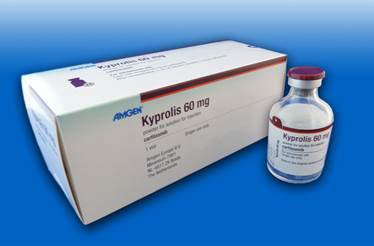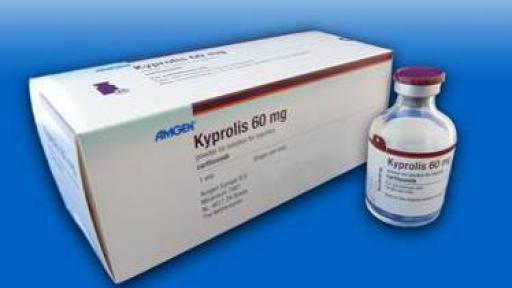

Media Panel
Related Documents
Related Links
Download Video
EUROPEAN COMMISSION APPROVES KYPROLIS® (CARFILZOMIB) FOR COMBINATION USE IN THE TREATMENT OF PATIENTS WITH RELAPSED MULTIPLE MYELOMA
First Irreversible Proteasome Inhibitor for Relapsed Multiple Myeloma Approved in the European Union
Approval Based on Data From Pivotal Phase 3 ASPIRE Trial Which Demonstrated Patients Treated With Kyprolis in Combination Lived Nearly Nine Months Longer Without Disease Progression Compared to Common Treatment Course
THOUSAND OAKS, Calif. (Nov. 19, 2015) – Amgen (NASDAQ:AMGN) today announced the European Commission (EC) granted marketing authorization for Kyprolis® (carfilzomib) in combination with lenalidomide and dexamethasone for the treatment of adult patients with multiple myeloma who have received at least one prior therapy. Kyprolis is the first irreversible proteasome inhibitor approved in the European Union (EU) for use in combination treatment of patients with relapsed multiple myeloma.1
“The approval of Kyprolis in combination provides physicians and patients across Europe with an important new treatment option for relapsed multiple myeloma, helping to address a real unmet need for this rare blood cancer,” said Sean E. Harper, M.D., executive vice president of Research and Development at Amgen. “Multiple myeloma is a complex blood cancer that often becomes resistant to treatment, which is why there is a need for new therapeutic options that provide deep and durable responses to extend the time patients live without their disease progressing.”
Multiple myeloma is an incurable blood cancer, characterized by a recurring pattern of remission and relapse.2 It is a rare and very aggressive orphan disease that accounts for approximately one percent of all cancers.3-5 In Europe, approximately 39,000 patients are diagnosed with multiple myeloma each year and 24,000 patient deaths are reported on an annual basis.3
“In clinical studies, approximately one out of three patients achieved a complete response or better on the Kyprolis in combination with lenalidomide and dexamethasone arm, which is three times more frequent than in the lenalidomide and dexamethasone arm,” said Prof. Meletios A. Dimopoulos, M.D., Department of Clinical Therapeutics, National and Kapodistrian University of Athens, School of Medicine. “In addition, the regimen provided patients with more than two years without disease progression. These results are significant for patients with relapsed multiple myeloma, who are faced with worse outcomes each time they experience a relapse.”
The EC approved Kyprolis based on data from the pivotal Phase 3 ASPIRE (CArfilzomib, Lenalidomide, and DexamethSone versus Lenalidomide and Dexamethasone for the treatment of PatIents with Relapsed Multiple MyEloma) trial. The study showed that patients treated with Kyprolis in combination with lenalidomide and dexamethasone (regimen referred to as KRd) had increased median time to progressive disease (PD) or death by 8.7 months compared to patients treated with lenalidomide and dexamethasone (regimen referred to as Rd). The median progression-free survival (PFS) was 26.3 months in the KRd arm compared to 17.6 months in the Rd arm (HR: 0.69; 95 percent CI: 0.57 to 0.83; p=0.0001). The most common adverse events (AE) in the Kyprolis arm included pneumonia (1 percent), myocardial infarction (0.8 percent) and upper respiratory tract infection (0.8 percent). Discontinuation of treatment due to AEs occurred in 15 percent of patients in the KRd arm versus 18 percent of patients in the Rd arm.
Kyprolis received an accelerated assessment from the European Medicines Agency (EMA), and orphan drug designation in 2008, given to medicines intended for the treatment, prevention or diagnosis of a disease that is life threatening and has a prevalence in the EU of no more than five in 10,000 people.
Approval from the EC grants a centralized marketing authorization with unified labeling in the 28 countries that are members of the EU. Norway, Iceland and Liechtenstein, as members of the European Economic Area (EEA), will take corresponding decisions on the basis of the decision of the EC.
Amgen plans to submit data from the Phase 3 ENDEAVOR (RandomizEd, OpeN Label, Phase 3 Study of Carfilzomib Plus DExamethAsone Vs Bortezomib Plus DexamethasOne in Patients With Relapsed Multiple Myeloma) trial for potential authorization of Kyprolis in combination with dexamethasone in the EU. This data also serves as the basis of the supplemental New Drug Application of Kyprolis in combination with dexamethasone for patients with relapsed multiple myeloma, which has been accepted for priority review by the U.S. Food and Drug Administration (FDA).
About ASPIRE
The international, randomized Phase 3 ASPIRE trial evaluated Kyprolis in combination with lenalidomide and dexamethasone, versus lenalidomide and dexamethasone, in patients with relapsed multiple myeloma following treatment with one to three prior regimens. The primary endpoint of the trial was PFS, defined as the time from randomization to disease progression or death due to any cause, whichever is earlier. Secondary endpoints included overall survival (OS), overall response rate (ORR), duration of response (DOR), disease control rate, health-related quality of life (HR-QoL) and safety. Patients were randomized to receive Kyprolis (20 mg/m2 on days 1 and 2 of cycle one, escalating, if tolerated, to 27 mg/m2 subsequently), in addition to a standard dosing schedule of lenalidomide (25 mg per day for 21 days on, 7 days off) and dexamethasone (40 mg per week in 4 week cycles), versus lenalidomide and dexamethasone. In the Kyprolis arm, patients were given a 10 minute infusion on days 1, 2, 8, 9, 15 and 16. Kyprolis was omitted on days 8 and 9 during cycles 13-18 and not administered beyond 18 cycles. The study randomized 792 patients at sites in North America, Europe and Israel.
While the data for median OS were not yet mature at the time of primary analysis, the analysis showed a trend in favor of KRd compared with Rd (HR=0.79; 95 percent CI: 0.63-0.99; p=0.02 [1-sided]). Patients continue to be monitored for OS. The ORR was 87.1 percent with KRd and 66.7 percent with Rd. Median DOR was 28.6 months for patients receiving KRd (95 percent CI, 24.9 to 31.3 months) and 21.2 months for patients receiving Rd (95 percent CI, 16.7 to 25.8 months). In the KRd and Rd groups, 32 percent versus 9 percent of patients achieved a complete response or higher (stringent complete response [sCR] or complete response [CR]), a measurement indicating depth of response.
The rate of death due to AEs within 30 days of the last dose was balanced between the KRd arm and the Rd arm. The most common causes of death not due to PD occurring in patients in the KRd arm compared to the Rd arm included cardiac disorders (3 percent versus 2 percent), infection (2 percent versus 3 percent), renal (0 percent versus less than 1 percent) and other AEs (2 percent versus 3 percent). Serious AEs (SAEs) were reported in 60 percent of the patients in the KRd arm and 54 percent of the patients in the Rd arm. The most common SAEs reported in the KRd arm compared to the Rd arm were pneumonia (14 percent versus 11 percent), respiratory tract infection (4 percent versus 2 percent), pyrexia (4 percent versus 2 percent) and pulmonary embolism (3 percent versus 2 percent). Discontinuation of treatment due to AEs occurred in 15 percent of patients in the KRd arm versus 18 percent of patients in the Rd arm. AEs leading to discontinuation of Kyprolis occurred in 12 percent of patients and the most common events included pneumonia (1 percent), myocardial infarction (1 percent) and upper respiratory tract infection (1 percent).
The ASPIRE data were presented at the 56th Annual Meeting of the American Society of Hematology (ASH) and published in The New England Journal of Medicine in December 2014.1
About Kyprolis® (carfilzomib)
Proteasomes play an important role in cell function and growth by breaking down proteins that are damaged or no longer needed.6 Kyprolis has been shown to block proteasomes, leading to an excessive build-up of proteins within cells.7 In some cells, Kyprolis can cause cell death, especially in myeloma cells because they are more likely to contain a higher amount of abnormal proteins.7 The irreversibility of Kyprolis’ binding has also been shown to offer a more sustained inhibition of the targeted enzymes.8
Kyprolis is currently approved in the U.S. in combination with lenalidomide and dexamethasone for the treatment of patients with multiple myeloma who have received one to three prior lines of therapy.
Kyprolis is also indicated under FDA accelerated approval as a single agent for the treatment of patients with multiple myeloma who have received at least two prior therapies including bortezomib and an immunomodulatory agent and have demonstrated disease progression on or within 60 days of completion of the last therapy. Approval is based on response rate. Clinical benefit, such as improvement in survival or symptoms, has not been verified.
Kyprolis is also approved in Argentina, Israel, Kuwait, Mexico, Thailand and Colombia. Additional regulatory applications for Kyprolis are underway and have been submitted to health authorities worldwide.
Kyprolis is a product of Onyx Pharmaceuticals, Inc. Onyx Pharmaceuticals is a subsidiary of Amgen and holds development and commercialization rights to Kyprolis globally, excluding Japan.
Important EU Product Safety Information
This medicinal product is subject to additional monitoring. This will allow quick identification of new safety information. Healthcare professionals are asked to report any suspected adverse reactions.
Kyprolis treatment should be supervised by a physician experienced in the use of anti-cancer therapy. The most serious side effects that may occur during Kyprolis treatment include: cardiac toxicity, pulmonary toxicities, pulmonary hypertension, dyspnoea, hypertension including hypertensive crises, acute renal failure, tumour lysis syndrome, infusion reactions, thrombocytopenia, hepatic toxicity, posterior reversible encephalopathy syndrome (PRES) and thrombotic thrombocytopenic purpura/haemolytic uremic syndrome (TTP/HUS). The most common side effects are anaemia, fatigue, diarrhoea, thrombocytopenia, nausea, pyrexia, dyspnoea, respiratory tract infection, cough and peripheral oedema.
Please refer to the Summary of Product Characteristics for full European prescribing information.
Important U.S. Product Safety Information
Cardiac Toxicities
New onset or worsening of pre-existing cardiac failure (e.g., congestive heart failure, pulmonary edema, decreased ejection fraction), restrictive cardiomyopathy, myocardial ischemia, and myocardial infarction including fatalities have occurred following administration of Kyprolis. Death due to cardiac arrest has occurred within a day of Kyprolis administration.
Withhold Kyprolis for Grade 3 or 4 cardiac adverse events until recovery, and consider whether to restart Kyprolis based on a benefit/risk assessment.
Adequate hydration is required prior to each dose in Cycle 1. Monitor all patients for evidence of volume overload, especially patients at risk for cardiac failure. Adjust total fluid intake as clinically appropriate in patients with baseline cardiac failure or who are at risk for cardiac failure.
Patients > 75 years, the risk of cardiac failure is increased. Patients with New York Heart Association Class III and IV heart failure, recent myocardial infarction, and conduction abnormalities may be at greater risk for cardiac complications.
Acute Renal Failure
Cases of acute renal failure and renal insufficiency adverse events (renal impairment, acute renal failure, renal failure) have occurred in patients receiving Kyprolis. Acute renal failure was reported more frequently in patients with advanced relapsed and refractory multiple myeloma who received Kyprolis monotherapy. This risk was greater in patients with a baseline reduced estimated creatinine clearance. Monitor renal function with regular measurement of the serum creatinine and/or estimated creatinine clearance. Reduce or withhold dose as appropriate.
Tumor Lysis Syndrome
Cases of Tumor Lysis Syndrome (TLS), including fatal outcomes, have occurred in patients receiving Kyprolis. Patients with multiple myeloma and a high tumor burden should be considered at greater risk for TLS. Adequate hydration is required prior to each dose in Cycle 1, and in subsequent cycles as needed. Consider uric acid lowering drugs in patients at risk for TLS. Monitor for evidence of TLS during treatment and manage promptly. Withhold Kyprolis until TLS is resolved.
Pulmonary Toxicity
Acute Respiratory Distress Syndrome (ARDS), acute respiratory failure, and acute diffuse infiltrative pulmonary disease such as pneumonitis and interstitial lung disease have occurred in patients receiving Kyprolis. Some events have been fatal. In the event of drug-induced pulmonary toxicity, discontinue Kyprolis.
Pulmonary Hypertension
Pulmonary arterial hypertension (PAH) was reported in patients treated with Kyprolis. Evaluate with cardiac imaging and/or other tests as indicated. Withhold Kyprolis for PAH until resolved or returned to baseline and consider whether to restart Kyprolis based on a benefit/risk assessment.
Dyspnea
Dyspnea was reported in patients treated with Kyprolis. Evaluate dyspnea to exclude cardiopulmonary conditions including cardiac failure and pulmonary syndromes. Stop Kyprolis for Grade 3 or 4 dyspnea until resolved or returned to baseline. Consider whether to restart Kyprolis based on a benefit/risk assessment.
Hypertension
Hypertension, including hypertensive crisis and hypertensive emergency, has been observed with Kyprolis. Some of these events have been fatal. Monitor blood pressure regularly in all patients. If hypertension cannot be adequately controlled, withhold Kyprolis and evaluate. Consider whether to restart Kyprolis based on a benefit/risk assessment.
Venous Thrombosis
Venous thromboembolic events (including deep venous thrombosis and pulmonary embolism) have been observed with Kyprolis. Thromboprophylaxis is recommended and should be based on an assessment of the patient's underlying risks, treatment regimen, and clinical status.
Infusion Reactions
Infusion reactions, including life-threatening reactions, have occurred in patients receiving Kyprolis. Symptoms include fever, chills, arthralgia, myalgia, facial flushing, facial edema, vomiting, weakness, shortness of breath, hypotension, syncope, chest tightness, or angina. These reactions can occur immediately following or up to 24 hours after administration of Kyprolis. Premedicate with dexamethasone to reduce the incidence and severity of infusion reactions. Inform patients of the risk and of symptoms of an infusion reaction and to contact a physician immediately if they occur.
Thrombocytopenia
Kyprolis causes thrombocytopenia with recovery to baseline platelet count usually by the start of the next cycle. Thrombocytopenia was reported in patients receiving Kyprolis. Monitor platelet counts frequently during treatment with Kyprolis. Reduce or withhold dose as appropriate.
Hepatic Toxicity and Hepatic Failure
Cases of hepatic failure, including fatal cases, have been reported during treatment with Kyprolis. Kyprolis can cause increased serum transaminases. Monitor liver enzymes regularly. Reduce or withhold dose as appropriate.
Thrombotic Thrombocytopenic Purpura /Hemolytic Uremic Syndrome (TTP/HUS)
Cases of TTP/HUS including fatal outcome have occurred in patients receiving Kyprolis. Monitor for signs and symptoms of TTP/HUS. Discontinue Kyprolis if diagnosis is suspected. If the diagnosis of TTP/HUS is excluded, Kyprolis may be restarted. The safety of reinitiating Kyprolis therapy in patients previously experiencing TTP/HUS is not known.
Posterior Reversible Encephalopathy Syndrome (PRES)
Cases of PRES have occurred in patients receiving Kyprolis. PRES was formerly known as Reversible Posterior Leukoencephalopathy Syndrome. Consider a neuro-radiological imaging (MRI) for onset of visual or neurological symptoms, such as seizure, headache, lethargy, confusion, blindness, and altered consciousness, along with hypertension.. Discontinue Kyprolis if PRES is suspected and evaluate. The safety of reinitiating Kyprolis therapy in patients previously experiencing PRES is not known.
Embryo-fetal Toxicity
Kyprolis can cause fetal harm when administered to a pregnant woman based on its mechanism of action and findings in animals.
Females of reproductive potential should be advised to avoid becoming pregnant while being treated with Kyprolis and the potential hazard to the fetus if Kyprolis is used during pregnancy.
ADVERSE REACTIONS
The most common adverse events of all grades occurring in at least 20 percent of patients treated with Kyprolis in monotherapy trials: anemia, fatigue, thrombocytopenia, nausea, pyrexia, decreased platelets, dyspnea, diarrhea, decreased lymphocyte, headache, decreased hemoglobin, cough, edema peripheral.
The most common adverse events of all grades occurring in at least 20 percent of patients treated with Kyprolis in the combination therapy trial: decreased lymphocytes, decreased absolute neutrophil count, decreased phosphorus, anemia, neutropenia, decreased total white blood cell count, decreased platelets, diarrhea, fatigue, thrombocytopenia, pyrexia, muscle spasm, cough, upper respiratory tract infection, decreased hemoglobin, hypokalemia.
Full prescribing information for the U.S. is available at www.kyprolis.com.
About Amgen
Amgen is committed to unlocking the potential of biology for patients suffering from serious illnesses by discovering, developing, manufacturing and delivering innovative human therapeutics. This approach begins by using tools like advanced human genetics to unravel the complexities of disease and understand the fundamentals of human biology.
Amgen focuses on areas of high unmet medical need and leverages its biologics manufacturing expertise to strive for solutions that improve health outcomes and dramatically improve people's lives. A biotechnology pioneer since 1980, Amgen has grown to be one of the world's leading independent biotechnology companies, has reached millions of patients around the world and is developing a pipeline of medicines with breakaway potential.
For more information, visit www.amgen.com and follow us on www.twitter.com/amgen.
Forward Looking Statements
This news release contains forward-looking statements that are based on the current expectations and beliefs of Amgen Inc. and its subsidiaries (Amgen, we or us) and are subject to a number of risks, uncertainties and assumptions that could cause actual results to differ materially from those described. All statements, other than statements of historical fact, are statements that could be deemed forward-looking statements, including estimates of revenues, operating margins, capital expenditures, cash, other financial metrics, expected legal, arbitration, political, regulatory or clinical results or practices, customer and prescriber patterns or practices, reimbursement activities and outcomes and other such estimates and results. Forward-looking statements involve significant risks and uncertainties, including those discussed below and more fully described in the Securities and Exchange Commission (SEC) reports filed by Amgen Inc., including Amgen Inc.'s most recent annual report on Form 10-K and any subsequent periodic reports on Form 10-Q and Form 8-K. Please refer to Amgen Inc.'s most recent Forms 10-K, 10-Q and 8-K for additional information on the uncertainties and risk factors related to Amgen's business. Unless otherwise noted, Amgen is providing this information as of Nov. 19, 2015, and expressly disclaims any duty to update information contained in this news release.No forward-looking statement can be guaranteed and actual results may differ materially from those we project. Discovery or identification of new product candidates or development of new indications for existing products cannot be guaranteed and movement from concept to product is uncertain; consequently, there can be no guarantee that any particular product candidate or development of a new indication for an existing product will be successful and become a commercial product. Further, preclinical results do not guarantee safe and effective performance of product candidates in humans. The complexity of the human body cannot be perfectly, or sometimes, even adequately modeled by computer or cell culture systems or animal models. The length of time that it takes for us and our partners to complete clinical trials and obtain regulatory approval for product marketing has in the past varied and we expect similar variability in the future. We develop product candidates internally and through licensing collaborations, partnerships and joint ventures. Product candidates that are derived from relationships may be subject to disputes between the parties or may prove to be not as effective or as safe as we may have believed at the time of entering into such relationship. Also, we or others could identify safety, side effects or manufacturing problems with our products after they are on the market. Our business may be impacted by government investigations, litigation and product liability claims. If we fail to meet the compliance obligations in the corporate integrity agreement between us and the U.S. government, we could become subject to significant sanctions. We depend on third parties for a significant portion of our manufacturing capacity for the supply of certain of our current and future products and limits on supply may constrain sales of certain of our current products and product candidate development.
In addition, sales of our products (including products of our wholly-owned subsidiaries) are affected by the reimbursement policies imposed by third-party payers, including governments, private insurance plans and managed care providers and may be affected by regulatory, clinical and guideline developments and domestic and international trends toward managed care and healthcare cost containment as well as U.S. legislation affecting pharmaceutical pricing and reimbursement. Government and others' regulations and reimbursement policies may affect the development, usage and pricing of our products. In addition, we compete with other companies with respect to some of our marketed products as well as for the discovery and development of new products. We believe that some of our newer products, product candidates or new indications for existing products, may face competition when and as they are approved and marketed. Our products may compete against products that have lower prices, established reimbursement, superior performance, are easier to administer, or that are otherwise competitive with our products. In addition, while we and our partners routinely obtain patents for our and their products and technology, the protection of our products offered by patents and patent applications may be challenged, invalidated or circumvented by our or our partners' competitors and there can be no guarantee of our or our partners' ability to obtain or maintain patent protection for our products or product candidates. We cannot guarantee that we will be able to produce commercially successful products or maintain the commercial success of our existing products. Our stock price may be affected by actual or perceived market opportunity, competitive position, and success or failure of our products or product candidates. Further, the discovery of significant problems with a product similar to one of our products that implicate an entire class of products could have a material adverse effect on sales of the affected products and on our business and results of operations. Our efforts to integrate the operations of companies we have acquired may not be successful. We may experience difficulties, delays or unexpected costs and not achieve anticipated benefits and savings from our ongoing restructuring plan. Our business performance could affect or limit the ability of our Board of Directors to declare a dividend or our ability to pay a dividend or repurchase common stock.
###
CONTACT:
Amgen, Thousand Oaks
Kristen Davis, 805-447-3008 (Media)
Kristen Neese, 805-313-8267 (Media)
Arvind Sood, 805-447-1060 (Investors)
Amgen, Europe
Emma Gilbert, +41 41 369 2542
1. Stewart KA, Rajkumar VS, Dimopoulos MA, et al. Carfilzomib, Lenalidomide, and Dexamethasone for Relapsed Multiple Myeloma. N Engl J Med. 2015; 372:142-152.
2. Jakubowiak A. Management Strategies for Relapsed/Refractory Multiple Myeloma: Current Clinical Perspectives. Seminars in Hematology. 2012; 49(3)(1),S16-S32.
3. GLOBCAN 2012, Global Prevalence and Incidence, available at http://globocan.iarc.fr/old/summary_table_pop_prev.asp?selection=224900&title=World&sex=0&window=1&sort=0&submit=%C2%A0Execute%C2%A0, accessed on March 9, 2015.
4. American Cancer Society. Multiple myeloma. http://www.cancer.org/acs/groups/cid/documents/webcontent/003121-pdf.pdf. Accessed on: October 30, 2015.
5. Palumbo A and Anderson K, Multiple myeloma, N Engl J Med,2011;364:1046–60
6. Moreau P, Richardson PG, Cavo M, et al. Proteasome Inhibitors in Multiple Myeloma: 10 Years Later. Blood. 2012; 120(5):947-959.
7. Kyprolis® [package insert]. Thousand Oaks, CA: Amgen; 2015.
8. Kortuem KM and Stewart AK. Carfilzomib. Blood. 2012; 121(6):893-897.







